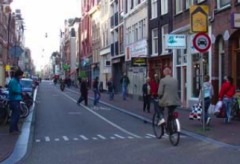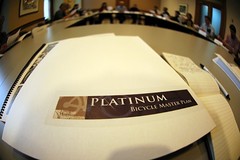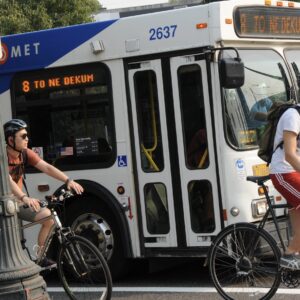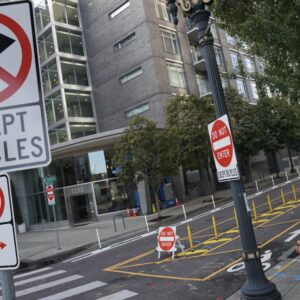As part of our ongoing look at the City of Portland’s Bicycle Master Plan update process, I thought it might be fun to take a look at some of the new bicycle infrastructure ideas being considered for use in Portland.
The City has published a draft of their “Suggested/recommended Bikeway Facility Types”. Many of them won’t be news to most of you — stuff like bike boulevards, sharrows, and bike lanes are old hat. But what’s neat about the Bike Master Plan Update project is that it’s an opportunity to get some new types of facilities into the city’s toolbox.
You’ll notice that many of these ideas come from Europe. This reflects the major influence cities like Amsterdam and Copenhagen have had (and will continue to have) on Portland’s bike network. Mayor (and Transportation Commissioner) Sam Adams, his chief of staff Tom Miller, City Traffic Engineer Rob Burchfield, Bike Coordinator Roger Geller, and PBOT traffic safety guru Greg Raisman are just a few of the many city staffers that have traveled abroad recently and brought back these ideas (Raisman, Adams, and Miller will travel to Brussels next month for the Velo-City Conference).
Below are a few recommended facility types that caught my eye (PBOT’s definition is in italics):
Car-free (Pedestrianized) Street
“Bicycle route through an area with restricted motor vehicles access”

To my knowledge there are none of these yet in existence in Portland. I assume the City would consider this type of facility in some parts of the Pearl District, once they make it into a “Bicycle District”. I could also see this happening near the South Park Blocks, which Commissioner Randy Leonard has said he could imagine eventually being car-free.
Advisory Bike Lane Without Centerline
“A dotted white line is used on a low-traffic roadway to indicate the space where bicycles have priority. This space may also be used by other vehicles when no bicycles are present.”

This is a very interesting concept that would require Portlanders to really learn to “share the road”. I have heard city staffers saying that a pilot treatment like this might be tried on small, residential streets in Outer East Portland.
Contraflow Bike Lane
“One way street with oncoming bike lane”

I think there’s one of these on a short, residential stretch of SE Clinton just east of 39th, but none that I’m aware of on a busy, one-way road downtown. Riding against oncoming traffic might sound a bit scary to some folks, but this type of treatment would only be used on narrow streets where motor vehicle speeds are kept to a minimum (or, at least that is my assumption).
It’s interesting to note that the three bikeway types above look to be very low cost. They simply require some paint and a bit of planning. That’s the exciting thing about making a city more bike-friendly, it doesn’t have to cost millions of dollars. But then of course, you can’t buy political will, which is often what this stuff comes down to.
— Learn more about the City’s Bicycle Master Plan update here and read our previous coverage on the Bicycle Master Plan category page.






Sure you can buy political will, it just costs more than paint 🙂
I think it will be interesting to see if any of these kinds of solutions actually work well in the US – my suspicion is that they work well in cities like Amsterdam and Copenhagen because automobile traffic is already strictly controlled, and people are used to driving relatively slow and in close proximity to other road users. I think if Portland is going to make them work here, they’re going to need some heavy enforcement of speed limits and boundaries, at least at first, so that people will actually treat them properly and not dangerously.
I should note – the carfree streets would be the exception to what I said in my last comment. I think carfree streets would suit Portland perfectly, especially in certain areas, and create great public spaces that would really be enjoyed by people in the city, without any kind of additional education, enforcement, propaganda, etc. All they need is some simple physical barrier to make sure people don’t drive on them (some of those are employed already in the south park blocks and other places).
It’s interesting to have this on one hand and CRC on the other. Obviously, CRC is more politically appropriate because of the amount of money involved in the project, but their effect is directly opposite to whatever bike infrastructure we build.
I agree with Dave’s comment (#1), that heavy speed limits and boundaries for cars are necessary to make these changes more than cosmetic ones, and building a new I-5 bridge (no matter how many lanes, or how “green”), will only produce more accessibility for cars, trucks and will necessitate higher speeds.
I hope that, in the end, we win.
Putting in those posts you see at the entrance to the Springwater every 5 blocks or so on bike boulevards or on streets the City wants to make car-free would cost next to nothing and would have a similar effect to more expensive engineering options.
Make Life SIMPLE: 86 paint.
“Generally speaking, what we want is for people to be confused,” said Willi Ladner, a deputy mayor in Bohmte, Germany. “When they’re confused, they’ll be more alert and drive more carefully.”
That’s actually a pretty interesting idea – since the bike boulevards are in connected neighborhoods as a rule, putting in a barrier like that every so often would discourage cars from using the bike boulevard as a through street to go a long distance, but would still allow people access to the street from side streets, so people could still get to their houses, shops, cafes, etc – they just couldn’t drive very far on the street. That would also make a huge difference in traffic speed on the streets, since cars would be restricted to only going a few blocks at a time.
Would it be easier to buy political will if the city doesn’t have to foot the entire bill? Does Portland have any provisions for community-executed projects? Do we have a list of projects that have been design-approved, but have not yet been implemented because of limited resources (time, budget cutbacks, etc)? I was thinking something like the community-executed bridge repair in Hawai’i (http://www.cnn.com/2009/US/04/09/hawaii.volunteers.repair/) meets Yehuda Moon (http://www.yehudamoon.com/index.php?date=2008-03-23).
These are great ideas and I would love to see things like this… but only after some of the bicycle wheel eating potholes and thrashed streets are fixed through out the city (this includes outer SE, outer NE and NoPo).
My issue with the above projects are that they are proposed for a small portion of the city (my guess is downtown and the Perl); where as I ride all over the city and roads that will not throw me off my bike are my first concern.
Let’s face it. The city is broke and is going to have to prioritize what limited funds they have. The political will of the people (driver and cyclists) is there to fix our existing streets.
It’s too bad the city is broke, because what we really need are bicycle-specific traffic signals (hundreds of them, not the 2 we currently have). That’s why cycletracks work in Europe: the signals, provided everybody obeys them, eliminate the right hook hazard.
Have you heard any talk about a general lowering of speed limits? It’s not a bike treatment per-se, but it’s a cheap and easy way to level the playing field on roads that are shared and make them safer. It would be a great enhancement to designated bike routes on shared streets to lower the speed limit.
Unless otherwise marked, the basic speed limit in a business district is 20, yet in residential districts it’s 25. It make no sense to have the residential districts even faster than business districts. Schools – 20 MPH, in front of the homes where those school kids live – 25 MPH. How about starting the safe route to school at home? How does 15 MPH sound?
On the Contra flow bikelane:
I see it happening all of the time in the Milwaukie – Oak Grove area. Dudes riding against the traffic at night with no lights, dark clothes and smoking a cigarette, oh yeah, with ear buds in too, of course! I wonder how they have lived so long..
15 mph is a bad idea, as I would often be breaking the speed limit on my bike.
I am not a fan of most bicycle-specific infrastructure, at least as applied to North American cities. I am a fan of “de-highway-ifying” city streets, however. Here is my recipe for bike-friendliness: The cheapest way to make a city bike-friendly would be to impose a 30 mph speed limit on all city streets (25 mph in residential areas). Convert four-lane arterial streets to three lane streets with wide outside lanes and center turn lanes. In the suburbs, make sure that there is a lower speed residential route that actually connects running roughly parallel to every high-speed 4-6 lane street. Then reduce the lanes of the main street. Buy out some of the side yards of people living on cul-de-sacs for bicycle/pedestrian cut-throughs. Add more underpasses and overpasses across highways and railroad tracks to facilitate easy crossing. Eliminate non-interstate highways that don’t serve the purpose of transporting vehicles to and from other metro areas.
I have no use for European-style cycle tracks or bike lanes.
i’d like to see a good stretch of fremont get that advisory bike lane. it’s a nice neighborhood and nice street to ride down except it’s really narrow and people are constantly squeezing by you. it would be great to just let them know, “hang on, it’s kind of tight through here, if you wait a second longer you can pass!”
I suppose one nice thing about the advisory bike lane, is that it would technically be in the “drivable” area, so it might get kept up a bit better than the gutters where the striped lanes are usually put 🙂
@ Shoemaker #10. The speed limit on Division St. below 50th is 25 MPH all the way. Do motorists obey it? Heck no! Do the police enforce it? Heck no!
Same thing for lower Hawthorne, the speed limit was just lowered to 25, the motorists don’t obey it and the police don’t enforce it.
You can install speed humps for passive speed limit enforcement. I prefer them to those islands in the middle of Clinton and Lincoln, which can lead to motorists attempting to pass when they don’t have room to. Still, I don’t have any problems riding on Hawthorne or Division. They aren’t like 82nd Ave, which I would never ride on for more than a couple of blocks (which is usually at night, between bursts of traffic).
I loved that German idea, until I got to this part…”everyone has to yield to the right, regardless of whether it’s a car, a bike or a baby carriage.”
Voluminous debate on this subject has proven that Oregon motorists are vehemently unwilling to embrace this Euro-fangled ‘yield’ concept.
Lowering residential speed limits…I’m so with you. Bollards too.
@chrisnw #12 “impose a 30 mph speed limit on all city streets (25 mph in residential areas).”
Are you suggesting we ditch the school and business district limits as well?
Me personally, I’m for maximum bike, not maximum speed. I can’t see kids and older adults riding along casually at 15 MPH with motor vehicles passing them from behind at twice that speed. And guess what? I don’t see those people on the road in any significant numbers given their percentage of the population. Hmmm.
Bikes are certainly capable of awesome speeds but we can clearly show that there’s an inverse relationship between speed and safety regardless of your mode of travel. I see nothing but benefits from turning it all down a notch.
Looking forward to some of the “car-free” streets being implemented. There’s a contra-flow bike lane on NE 22nd between Sandy and NE Irving already. It was put in as part of the Sandy Blvd streetscape project – really the least that could be done since the City neglected to paint bike lanes on that street…
i think this comment is too long…
i’m an ex-portland biker living in amsterdam for the last 9 months. i feel that portland is actually a more enjoyable cite to bike in than amsterdam. yes, i said it. and during the winter months, when everyone in portland is mellow, it is twice as nice in portland.
portland has to be much different in its bike infrastructure simply due to its size. amsterdam traffic models probably aren’t going to have much of a safety impact in portland because everyone bikes much faster.
which isn’t to say that portland bikes need to slow down. biking in portland *must* be faster than in amsterdam. most people in amsterdam ride at a jogging pace. literally. riding in amsterdam at any pace beyond a solid run puts you in much more danger than it would in portland. how often would you ride from SE to NE if you were going at a jogging pace? probably only once, if you ever made it back. my hunch is that if a ride takes more than a half hour people will not do it consistently.
on the specific proposals: “pedestrianized streets”. good if everyone riding a bike wants to be riding at a walking pace. otherwise they are annoying to both pedestrians and bikers. i just got caught in one an hour ago and had to say, “f* it”. and walked my bike to the next intersection.
the “advisory” bike lanes feel really good on very low traffic streets. but, very low traffic streets already feel pretty good, so i’m not sure of the point. i suppose just some color on the road makes drivers a little more alert. maybe. i have only seen these in the country and small towns, not actually in the city.
all the one-way streets here are “contraflow” — painted or not, and with the exception of the street pictured (which is probably the widest street in amsterdam), these are generally very narrow and dangerous routes. portland streets are quite wide by comparisson, and as a result this approach might work. but i have to ask, why not just make a whole lane on the next street dedicated to bikes? haarlemmerstraat (pictured) is the only way to get from east to west on a bike for several blocks to the north and south. and it is really only a delivery street, not really a “for-cars” street (delivery trucks stop and block all car traffic for 20 minutes at a time). anyway, i diverge, where in portland are there one way streets that don’t have traffic running the opposite direction one block away? i’m sure there must be some, but i can’t think of any off the top of my head.
i’m not trying to belittle the efforts of the people trying to figure out ways to improve portland cycling. it definitely needs attention, because it is a long ways from safe. it is just that often the euro-plans don’t really make sense in the portland context simply because portland biking happens at much higher speeds. not to mention that what portland has implemented is already better than any of the fancy euro-paths. these fancy paths are all reactions to a city built before cars, and a city in which it is simply easier to ride a bike than to drive a car. if anything, these paths are an attempt to make a safe place for cars to go faster. europeans just have a very different set of issues to resolve.
i think what portland has done with great success already is creating bike boulevards. i was lucky enough to have my commute up harrison/lincoln last year, which does have lazy speed bumps and a traffic flow impediment at 20th and 39th and that was really really really nice. don’t know why there weren’t more traffic impediments at 30th, 50th, and 60th, but just those two were a tremendous help. i would recommend those in every residential neighborhood, and i would present it to the public as a “family protection” or “quiet neighborhood” angle, not a “bike protection” angle, which would get the “political capital” that i always read about. there is very little reason that neighborhoods don’t set these up (i’m thinking ne tillamook right now — that street is a horrible!!). then you could also get rid of all those stop signs (tangential — the only stop sign i’ve seen in amsterdam was in the ikea parking lot).
in summation, people will bike in amsterdam because it is more convenient, and the city has to address how to make that possible. for most riders the opposite is true in portland, so you need to make biking fun and temporally viable (20 to 30 minutes from point to point). bike boulevards allow for both of these, while making the side streets safer for families with small children or blind cats. from my perspective, hauling ass down lincoln on a quiet tuesday morning is much more fun than dodging all manner of obstacles at a running pace in amsterdam.
outside of amsterdam the dutch win with style, but that is another topic.
I agree that solutions that work in Europe won’t always work out here, because our cities are laid out so differently – or at least, they may work, but only in certain areas of town, rather than all throughout the city.
I also agree that bike boulevards seem to be a great solution for Portland, as well as sort of “green trails” like the path along the waterfront. I know it’s frustrating for some cyclists to have to deal with pedestrian traffic, but there are also a lot of cyclists (and would-be cyclists) who would much rather deal with pedestrian traffic than automobile traffic, so I think there really is significant benefit to car-free areas (and not only from a bike perspective, but just a general livability perspective – as a pedestrian, I’ve loved car-free areas in other cities I’ve lived in). If you’re really that frustrated with slower pedestrians, you can always choose not to ride where there are pedestrians.
I think probably one of the better ways to go would be just to create more bike boulevards, create easy connections between them, and then just start putting in bike parking in as many places as possible. I like the idea of labeling the bike boulevards differently as well, as they really are an enhancement to neighborhoods (they’ve seen property values and such go up in neighborhoods where they’ve put in bike boulevards), and re-naming them might take away some of the “catering to special interests” vibe that people seem to get off on.
I think the whole 20 minute neighborhood idea is crucial in Portland too – zoning and arranging areas of the city so that most of a person’s daily trips can be within that 20-30 minute walking distance range (which would be more like 5-15 min by bike).
Our cities are laid out for cars.
Obviously that simple infrastructure changes can’t do much, but it’s about time we “slow things down”. Bikes and cars.